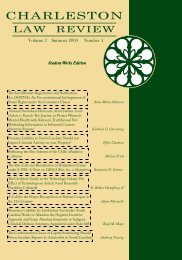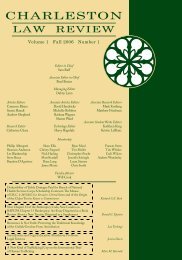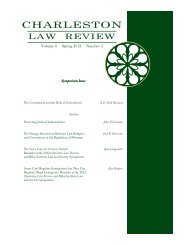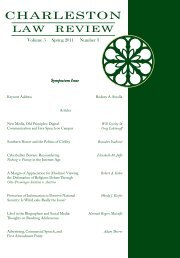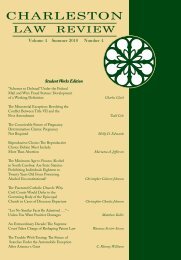Volume 5 Winter 2011 Number 2 - Charleston Law Review
Volume 5 Winter 2011 Number 2 - Charleston Law Review
Volume 5 Winter 2011 Number 2 - Charleston Law Review
You also want an ePaper? Increase the reach of your titles
YUMPU automatically turns print PDFs into web optimized ePapers that Google loves.
<strong>2011</strong>] Learning StylesA. The Validity and Reliability QuestionsEducators, cognitive psychologists, sociologists, and expertson professional development have conducted and publishedextensive analyses of the research foundation for learning styles.Much of this analysis has concluded that there is a lack ofscientifically valid inquiry to support the underlying bases for theindividual learning style theories and the related propositionsthat teaching intervention is necessary to teach to students’styles. They have also found that the associated instrumentslack reliability and validity. 91Critics of learning styles research acknowledge the “facevalidity,” or common-sense appeal, of some of the diagnosticinstruments. In other words, many learning styles theoriesattract support because they appeal “to the intuitive sense ofwhat ‘feels right.’” 92 They note, however, that the “forced-choicequestionnaires” common to learning styles instruments may notmeasure “anything in particular” or, worse, may measure“something completely different from what one intends toPerformance, Journal of Experimental Psychology: Learning, Memory, andCognition, and Behavioral and Cognitive Neuroscience <strong>Review</strong>s, among others,has posted a video on YouTube titled “Learning Styles Don’t Exist.” dbw8m,Learning Styles Don’t Exist, YOUTUBE (Aug. 21, 2008), http://www.youtube.com/watch?v=sIv9rz2NTUk. The video briefly explores the appeal of learning stylestheory, and, focusing specifically on VAK, explains the fallacy of the theory. Id.His curriculum vitae and a link to his video may be found on his website,http://www.danielwillingham.com (last visited Oct. 22, 2010).91. “An instrument has validity if it measures what it claims to measure,”whereas “[a]n instrument is reliable if it produces the same result whenmeasuring the same thing.” Jacobson, Using the Myers-Briggs Type Indicator,supra note 42, at 280, 293; see also Vicki E. Snider, Learning Styles andLearning to Read: A Critique, 13 REMEDIAL AND SPECIAL EDUC. 6 (1992)(critiquing the application of learning styles in teaching students withdisabilities to read because, among other factors, learning styles are difficult toassess and there is a lack of convincing research to support the theories);Timothy J. Sewall, The Measurement of Learning Style: A Critique of FourAssessment Tools (1986) (examining the psychometric qualities of four learningstyles instruments, including the Kolb LSI and the Myers-Briggs TypeIndicator) available at http://eric.ed.gov/ERICWebPortal/search/detailmini.jsp?_nfpb=true&_&ERICExtSearch_SearchValue_0=ED267247&ERICExtSearch_SearchType_0=no&accno=ED267247.92. Dembo & Howard, supra note 31, at 103.153



